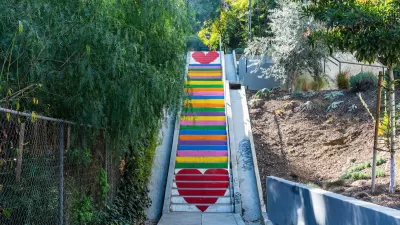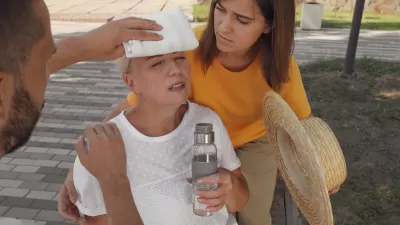Nevada legislators are proposing laws that would mandate heat mitigation measures to protect residents from the impacts of extreme heat.

This article is republished from Nevada Current.
As temperatures soared past 100 degrees in early October, Yajaira Rimendes, a 35-year-old former nurse, started to feel faint at a bus stop in North Las Vegas. It was midday and she was on her way to a chemotherapy appointment. She drank her only remaining water, which was already lukewarm, and passed out.
“I don’t remember much, but from what I remember I woke up in a hospital,” Rimendes said.
She was one of more than 3,500 heat-related emergency hospital visits reported in Southern Nevada last year, according to the Southern Nevada Health District.
Last year Nevada experienced the hottest summer on record, and even into October, daily heat records were broken, triggering a re-activation of cooling centers. Temperatures on Oct. 4 reached 104 degrees, breaking the record for the hottest day ever recorded for the month.
Extended triple degree temperatures in 2024 also brought a surge of fatalities. State health officials recorded 526 heat-related deaths in Southern Nevada last year, a 78% increase from the 294 heat-related deaths in 2023.
After a record number of heat related deaths and hospitalizations in the state, lawmakers are considering measures this session designed to protect Nevadans whose vulnerability to heat is only rising with temperatures.
Rimendes joined dozens of Las Vegas residents on a trip to Carson City with the Nevada Environmental Justice Coalition this month — traveling more than 400 miles — to push for several bills that would help Nevadans adapt and thrive as record-breaking temperatures and wildfire impact every aspect of their lives.
Extreme heat exposure is a serious health hazard. It can cause heat rash, cramps, heat exhaustion, or heat stroke, which can be fatal or have lifelong consequences. Older people, people with disabilities, pregnant people, and children are at increased risk of adverse health impacts from heat, in some cases with fatal consequences.
At face value, policies to protect against the consequences of climate change seem like an obvious necessity, but lack of funding combined with fiercely anti-regulatory corporate interests and like-minded elected officials have made climate-related legislation difficult to pass.
One example is Assembly Bill 96, a measure that would mandate the Clark and Washoe counties, the state’s two most populous, to include a specific “heat mitigation” section within their development master plans. That would mean actively addressing extreme heat through urban planning strategies, like creating public cooling spaces, public water access, cool building practices, and shaded areas.
Nevada’s Republican Gov. Joe Lombardo vetoed a similar bill in 2023. His reasoning was that there’s “no data definitively supporting the proposition that development is causing rising temperatures in either Washoe County or Clark County.”
In reality, one of the major consequences of urban development is the urban heat island that results in cities being, on average, warmer than adjacent rural landscapes. As natural land and vegetation is replaced by dark and heat-absorbing surfaces like asphalt and concrete, the urban heat island is amplified at night when stored daytime heat is emitted even when the sun is down.
After 18 years of living in Nevada, Rimendes said the heat feels different than it did even five years ago. It’s more persistent, and her mobile home is no longer effective enough at creating a barrier from the intensity of the summer heat in North Las Vegas.
Her observation is backed by data. From 2010 to 2019, the low temperature in Las Vegas increased by 7 degrees, according to the nonpartisan Climate Central research and communications group. Much of that increase can be attributed to explosive development in Las Vegas since the 1970s.
A recent comparative study of cities by the U.S. Geological Survey found that nearly 50% of the Las Vegas metro area was covered by heat-absorbing buildings, roads and sidewalks — more than any other city in the study — contributing to significantly higher air temperatures in the area.
Nothing but a pole for shade
Nevada’s capital—where the Legislature meets once every two years— is 431 miles away from the Las Vegas Metropolitan Area, where seven out of ten Nevadans live. That’s farther than Las Vegas to Phoenix. It’s farther than Las Vegas to Salt Lake City. It’s farther than Las Vegas to Los Angeles.
Tollis Hill, a Las Vegas resident, packed into the Carson City office of Sen. Edgar Flores (D-Las Vegas) with a dozen other Nevada Environmental Justice Coalition members to advocate for more action on climate change.
Hill traveled with Chispa Nevada from Las Vegas to advocate for Senate Bill 260, a measure that would ensure that outdoor workers receive the protection when air quality reaches unhealthy levels due to the wildfire smoke. It was his first time ever going to Carson City or speaking to lawmakers.
Nearly one-fifth of Nevada’s land area has been burned by wildfire in the past 40 years, landing the state fifth in the nation for land area burned by wildfires. More frequent and destructive wildfires have also impacted air quality for outdoor workers in the state from Reno to Las Vegas. Despite growing destructive wildfires in the state, there are currently no regulations to protect workers air quality during extreme weather events.
Hill spent 15 years working casino security on the Las Vegas Strip, including seven years as an outside bike officer. He recalled times the air quality was so bad during wildfires that he couldn’t stop coughing and had to rely on an inhaler.
“In 2022, when Southern Nevada was filled with wildfire smoke, my coworkers and I were still outside working. We were not provided the needed personal protective equipment, and using what we had was discouraged as it did not meet the company’s uniform code,” Hill said.
Members of the Nevada Environmental Justice Coalition split up to speak to different legislators in order to maximize their lobbying time. They also provided comments during legislative hearings that coincided with their trip to Carson City.
Rimendes, the 35-year-old former nurse who is fighting cancer, has practiced telling her story in an effective and compelling way in 2-minutes or less — the time allotted by legislative committees to an individual to submit public comment on legislation during a hearing.
There’s no guarantee any of the bills the coalition supports will make it into law at the end of the 120-day legislative session, despite lobbying efforts by coalition members. Alternatively, the measures could be approved, but in a much different form than what was originally proposed.
One example is Senate Bill 431. The measure’s original goal was to extend the state’s 9% live entertainment tax to sports teams ticket sales, which are currently exempted from the tax. The bill would have brought the state $54.5 million in revenue and dedicated part of that revenue to fund Nevada’s woefully underfunded public transit. Funding that could be used to improve transit wait times, upgrade bus shelters to provide shade, and expand routes.
Rimendes relies heavily on public transit, even on days when temperatures soar past 100 degrees. That means at times Rimendes is forced to wait up to an hour at a bus stop with nothing but a pole for shade. Drive past any major road in Las Vegas and you’ll find several bus stops without trees or shelters to keep people cool as they stand on hot concrete near a sizzling asphalt road.
“There isn’t any shade, there aren’t any benches, there’s no trees. Imagine 110 degree weather, standing out there in scorching hot sun,” Rimendes said.
Rimendes and other coalition members urged lawmakers to pass the bill in it’s original form. Days later, the bill was stripped down during a work session after the Golden Knights, a pro league hockey team, and the Reno Aces, a pro baseball team, opposed the bill each saying it would raise ticket prices.
Senate Bill 431 now limits the live entertainment tax to only the resale of sports teams tickets. And instead of $54.5 million to improve public transit infrastructure, the bill is projected to generate $36.5 million.
Other environmental justice bills pushed by members of the coalition day died days later.
Jacqueline Banderas Gonzalez was aware that Assembly Bill 456 — a measure that would have prevented utility disconnections during extreme weather — had an uphill battle when she went to Carson City. For Banderas-Gonzalez, the journey was worth it if she could get lawmakers to understand what’s at stake if the government fails to enact adequate heat action plans.
Banderas Gonzalez, a mother of five, recounted a moment last summer when her power was cut off in the middle of the Las Vegas summer after she fell short $33 on her $400 power bill.
She is one of nearly 32,000 Nevadans who had their power disconnected by NV Energy for nonpayment in 2024, according to the Public Utilities Commission of Nevada. Year-by-year the number of disconnections for nonpayment has increased as the cost of utilities have gone up, in large part as a result of extreme weather.
NV Energy is prohibited from cutting off power to delinquent residential customers when the temperature is forecast to exceed 105, but any lower and it’s free game. And once power is cut, NV Energy is not required to reconnect, no matter how high temperatures get.Banderas-Gonzalez said she hoped Senate Bill 442, a measure that would require utilities to report on a quarterly basis the number of disconnections due to non-payment broken down by month and zip code, might have a better chance. It’s not exactly what she wants, but she’ll take what she can get.“It’s tiring, but for me it’s necessary if we want to be heard,” Banderas-Gonzalez said in her native Spanish. “Almost all of us lost work days to get here, but we want our voices to be heard. We want change that can help everyone.”
FULL STORY: Record temperatures prompt push for environmental justice bills

Alabama: Trump Terminates Settlements for Black Communities Harmed By Raw Sewage
Trump deemed the landmark civil rights agreement “illegal DEI and environmental justice policy.”

Planetizen Federal Action Tracker
A weekly monitor of how Trump’s orders and actions are impacting planners and planning in America.

The 120 Year Old Tiny Home Villages That Sheltered San Francisco’s Earthquake Refugees
More than a century ago, San Francisco mobilized to house thousands of residents displaced by the 1906 earthquake. Could their strategy offer a model for the present?

Opinion: California’s SB 79 Would Improve Housing Affordability and Transit Access
A proposed bill would legalize transit-oriented development statewide.

Record Temperatures Prompt Push for Environmental Justice Bills
Nevada legislators are proposing laws that would mandate heat mitigation measures to protect residents from the impacts of extreme heat.

Downtown Pittsburgh Set to Gain 1,300 New Housing Units
Pittsburgh’s office buildings, many of which date back to the early 20th century, are prime candidates for conversion to housing.
Urban Design for Planners 1: Software Tools
This six-course series explores essential urban design concepts using open source software and equips planners with the tools they need to participate fully in the urban design process.
Planning for Universal Design
Learn the tools for implementing Universal Design in planning regulations.
Clanton & Associates, Inc.
Jessamine County Fiscal Court
Institute for Housing and Urban Development Studies (IHS)
City of Grandview
Harvard GSD Executive Education
Toledo-Lucas County Plan Commissions
Salt Lake City
NYU Wagner Graduate School of Public Service





























